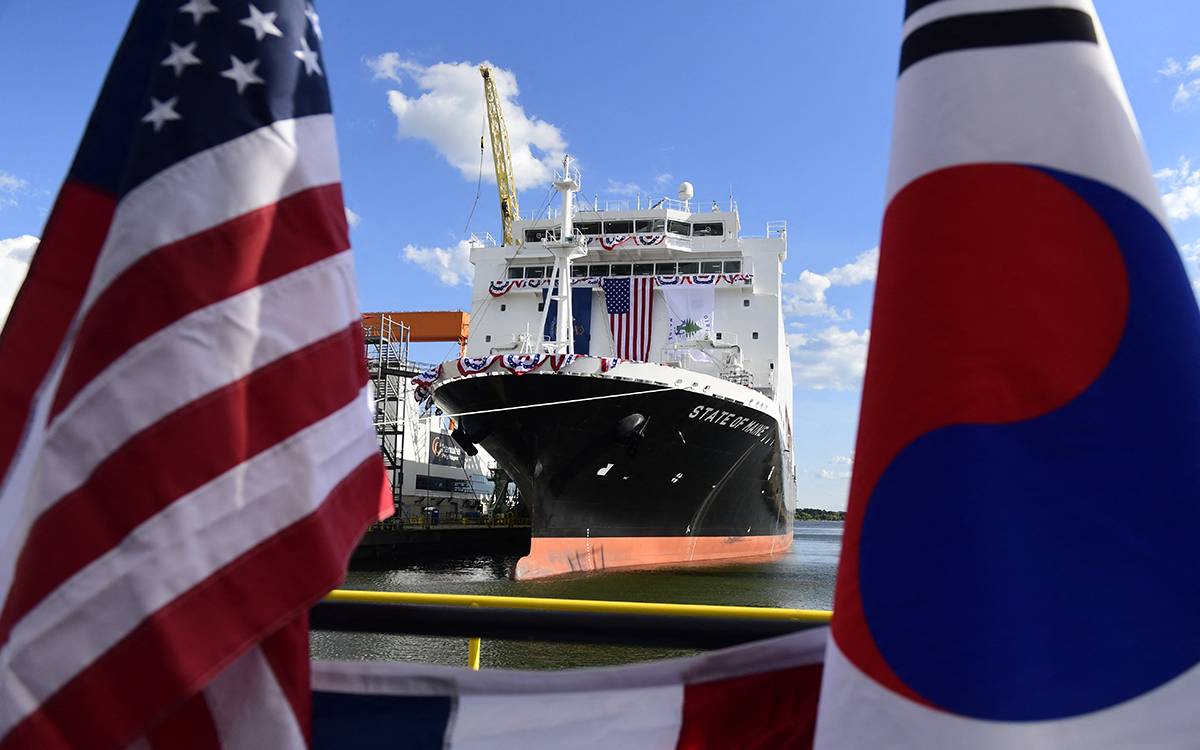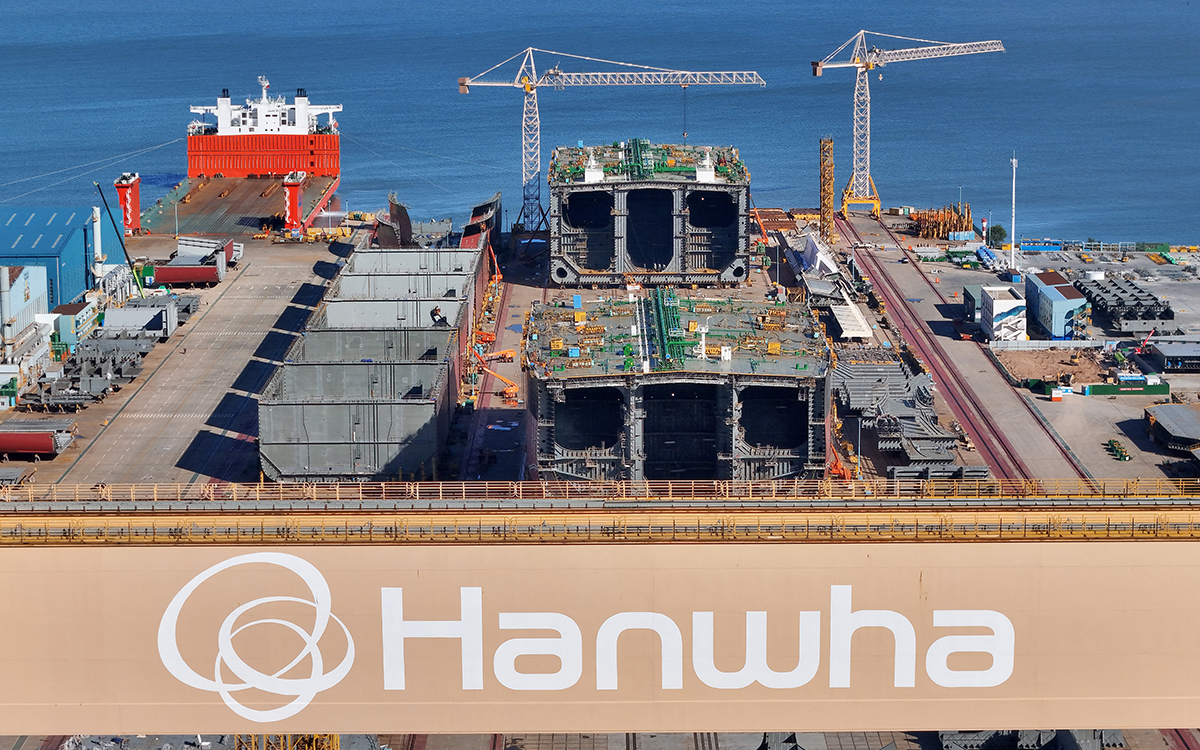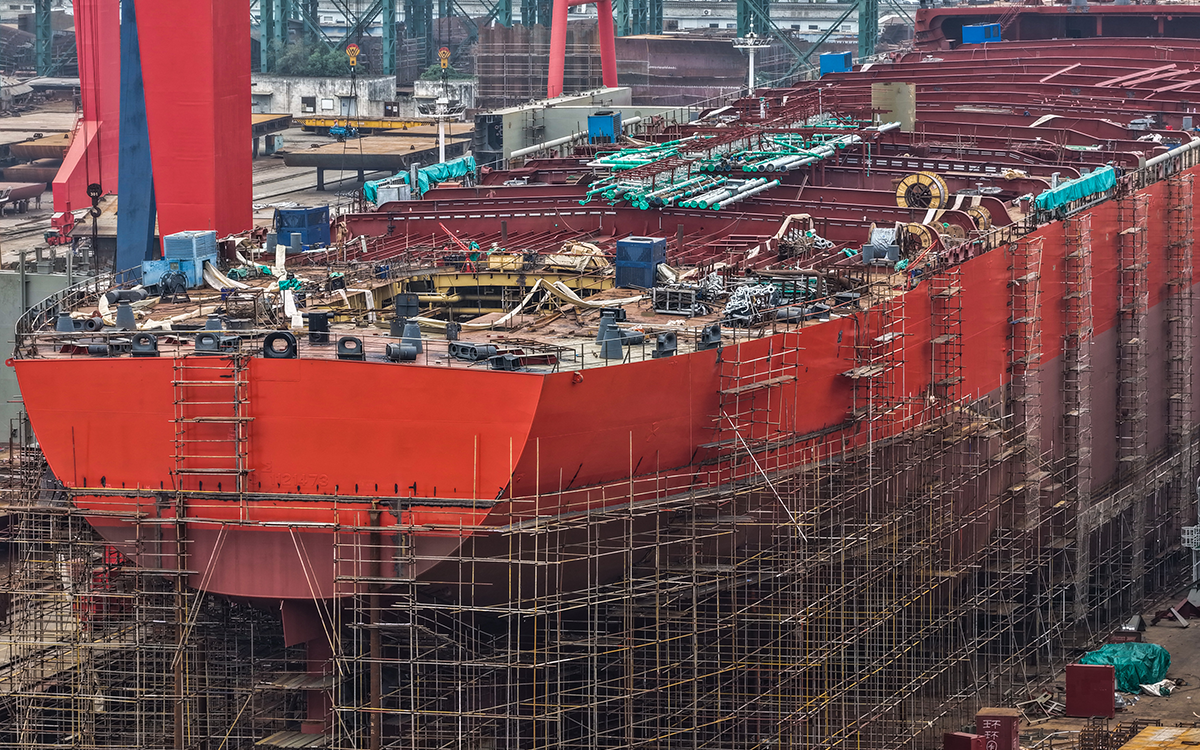


In a move that underscores the deepening geopolitical rivalry between Washington and Beijing over strategic industries, China’s Ministry of Commerce on October 14, 2025, announced sanctions against five US-based subsidiaries of the South Korean shipbuilder Hanwha Ocean, which included Hanwha Shipping, Hanwha Philly Shipyard, Hanwha Ocean USA International, Hanwha Shipping Holdings, and HS USA Holdings Corp. The sanctions, implemented under China’s Anti-Foreign Sanctions Law, prohibited all Chinese organizations and individuals from engaging in any transactions, cooperation, or related activities with the listed entities.
One of the primary firms included in the sanctions was the Philly Shipyard in Philadelphia, which the Hanwha Group acquired in a $100 million deal last year. The shipyard is referred to as one of the symbols of the “MASGA” (Make American Shipbuilding Great Again) initiative, a shipbuilding cooperation project between South Korea and the US. The project could see a $150 billion fund aimed at revitalizing the US shipbuilding industry through South Korean investment. South Korean President Lee Jae-myung also highlighted this cooperation as one of the key developments in South Korea-US relations during his visit to Philadelphia in August.
Beijing explicitly cited the companies’ alleged support and assistance for the US Section 301 trade investigation into China’s maritime, logistics, and shipbuilding sectors, claiming this cooperation “jeopardized China’s sovereignty, security, and developmental interests.” However, after an agreement was reached following a meeting between US President Donald Trump and his Chinese counterpart Xi Jinping in Busan on the sidelines of the APEC Summit, the White House said China “will remove measures taken in retaliation for the US’s announcement of a Section 301 investigation and remove sanctions imposed on various shipping entities.” Nonetheless, the Chinese measures on Hanwha represented a possibility of significant escalation of the US-China industrial rivalry, directly targeting a key ally’s firm involved in Washington’s strategic push to revitalize its domestic shipbuilding capacity.
The sanctions were specifically designed to undermine the burgeoning South Korea–US naval shipbuilding cooperation. Hanwha Ocean has become a central partner in the American effort to diminish China’s global dominance in shipbuilding, a sector that Beijing not only considers nationally strategic but also one in which it maintains a commanding global lead. It directly targeted Hanwha’s cooperation with the US under the MASGA initiative, highlighted by Hanwha’s acquisition of the Philly Shipyard and Seoul’s pledge to invest multi-billion dollars to support US naval and commercial vessel production.
The sanctions were specifically designed to undermine the burgeoning South Korea–US naval shipbuilding cooperation
By banning transactions with Hanwha’s US entities, Beijing sent an unambiguous signal to South Korean and other allied firms that participating in Washington’s strategic industrial policies would incur economic costs, effectively leveraging China’s market as a tool of geopolitical coercion against US alliance strategies. Moreover, the sanctions came as the Office of the US Trade Representative (USTR) decided in April to impose significantly higher port fees on vessels built, owned, or operated by Chinese entities, starting on October 14, which coincided with the timing of the Chinese sanctions. Although the port fees have also been suspended on both sides for a year after the Trump-Xi talks, the friction confirms that the maritime sector is now a primary front in this geopolitical confrontation.
Although the port fees have also been suspended on both sides for a year after the Trump-Xi talks, the friction confirms that the maritime sector is now a primary front in this geopolitical confrontation
Though Chinese sanctions on the shipbuilding industry in retaliation for the Section 301 investigation will be removed as a result of the Trump-Xi meeting, which would likely include relieving the measures on Hanwha Ocean, Beijing’s actions targeting the MASGA initiative still showcase potential risks. These risks may follow in the foreseeable future of the US-China trade war and the regional security, posing a credible threat to US naval readiness and shipbuilding capacity across two main vectors: maintenance and supply chain stability.
First, Hanwha Ocean has secured contracts with the US Navy to perform maintenance, repair, and overhaul (MRO) work on US naval vessels. Hanwha completed its overhaul of the USNS Wally Schirra, a US Navy sealift command supply ship, at its shipyard in southeastern Korea in March, seven months after receiving what was its first-ever MRO order from the US military. Since then, Hanwha Ocean has secured two more MRO deals from the US Navy, increasing its prospects of being a key player in the American naval shipbuilding industry. The shipbuilding industry in the US, in recent years, has suffered from the lack of capability to catch up with the increasing demand for naval shipbuilding, rooted in the limitations of its shipyards’ capacity and persistent workforce challenges. Consequently, the sanctions could have interfered with the shipyard’s operations, potentially delaying crucial MRO schedules and impacting the operational availability of Navy ships, had they not been removed following the Trump-Xi meeting.
Second, the sanctions created a broader risk of supply chain disruption to US shipbuilding efforts. The sanctions threatened to increase the cost and complexity of sourcing materials for Hanwha’s US operations, thereby obstructing the overall US initiative to ramp up a globally competitive, domestic industrial base capable of supporting the US Navy’s requirements. The action aimed for a chilling effect on future allied investment in the US defense-industrial base, making an example of a key South Korean firm and slowing the transfer of critical shipbuilding knowledge necessary for the US to achieve its strategic naval goals.
While the Jones Act requires certain naval vessels to use American steel, China still accounts for a significant share of South Korean shipbuilders’ supply chain in lower-cost, high-volume components. The sanctions order, therefore, could have acted as a regulatory poison pill, where Chinese component suppliers, fearing potential secondary sanctions or blacklisting from Beijing, would have likely implemented a cautious, self-imposed ban on supplying any Hanwha-affiliated US projects.
This forced pivot could have ultimately increased the cost and complexity of production at facilities like the Philly Shipyard. Hanwha would have been compelled to immediately and expensively re-source these components from non-Chinese suppliers, often American, European, or Japanese firms, who charge higher prices due to different labor costs and lower production volumes. According to an estimation by South Korean lawmaker Yu Yong-weon, the Chinese sanctions would have cost Philly Shipyard $60 million in potential losses over the next two years, stemming from supply disruptions and delivery delays.

However, China’s sanctions on Hanwha Ocean will likely have a profound, counterproductive effect on South Korea’s strategic alignment. Rather than dissuading South Korean firms from working with the US, Beijing’s action highlighted the geopolitical risk of relying on China for economic stability. The risk reminds Seoul of how it had to undergo China’s informal sanctions after allowing Washington to deploy the Terminal High Altitude Area Defense (THAAD) system on its territory in 2016. The measures had further pushed South Korea to closely cooperate with the US in countering Chinese influence in the region.
The United States faces a critical deficiency in its domestic shipbuilding and maintenance capacity, a problem underscored by the fact that the US accounts for less than one percent of global commercial output. Additionally, it struggles with multi-year delays and cost overruns in key naval programs. This industrial atrophy stems from decades of diminished government support and a severe shortage of skilled labor and modernized shipyard infrastructure.
The US faces a critical deficiency in its domestic shipbuilding and maintenance capacity, a problem underscored by the fact that it accounts for less than one percent of global commercial output
According to data from the Center for Strategic and International Studies (CSIS), American shipyards only built five large ocean-going merchant vessels in 2024, with a total volume of 76,000 gross tons. On the other hand, China State Shipbuilding Corporation (CSSC) alone delivered more than 250 ships that same year, totaling 14 million gross tons, more vessels by tonnage than the entire US shipbuilding industry has produced since World War II.
China’s strong shipyard capacity has also rapidly boosted its naval fleet. A Pentagon report in December described the PLA Navy fleet as the largest in the world, “with a battle force of over 370 ships and submarines, including more than 140 major surface combatants”, in contrast to the US Navy, known to have fewer than 300 vessels.
In response, Trump has repeatedly emphasized the importance of revamping the US naval shipbuilding industrial base since the start of his second term. He has called for massive capital investment and cooperation with allies with significant shipbuilding capacity, such as South Korea and Japan. In particular, South Korea is identified as a key strategic partner, leveraging its position as the world’s second-largest shipbuilder with advanced technology and efficient manufacturing processes.
According to data compiled by maritime consultancy Clarksons Research, China accounted for 75% of global shipbuilding orders in 2024, followed by South Korea with 14% in second place. However, China’s dominance in shipbuilding appears to be eroding. China’s global new orders dropped to 56 percent in the first half of this year, while South Korea’s share increased to 30 percent.
South Korea’s rebound reflects the Trump administration’s efforts to ramp up US shipbuilding capacity, particularly to meet Navy demands, through cooperation with shipbuilders in allied countries, notably South Korea. As reflected in the MASGA project, South Korea has committed substantial investment to the US shipbuilding sector, a plan epitomized by Hanwha Ocean’s acquisition of the Philly Shipyard.
South Korean expertise is essential for modernizing US shipyard infrastructure, where technological transfer and personnel training could accelerate the production of both commercial and naval-support vessels, crucially addressing the existing US Navy maintenance and overhaul backlog. This partnership is designed to establish a resilient, allied supply chain and military-industrial base that is less vulnerable to the market dominance and geopolitical pressure exerted by Beijing.
This Seoul-Washington partnership is designed to establish a resilient, allied supply chain and military-industrial base that is less vulnerable to the market dominance and geopolitical pressure exerted by Beijing
While it is true that the sanctions could have inflicted cost inflation that directly threatened the core US objective of building a globally competitive domestic shipbuilding base and disrupted the MASGA initiative’s goal of containing China’s rapid naval expansion, it also introduced countervailing dynamics that reinforce the US-South Korea strategic alignment. The political nature of Beijing’s coercion against Hanwha Ocean compels both Washington and Seoul to accelerate de-risking by fast-tracking the establishment of secure, non-Chinese supply chains and industrial integration.
Consequently, the Chinese coercion confirms to Seoul that economic interests can be leveraged against its security interests, thereby increasing domestic political will to favor a US-centric defense-industrial base, and ironically serves as an accelerator for South Korea’s closer defense industrial alignment with the US. While Beijing intended to coerce Seoul away from the US shipbuilding initiatives, its use of economic tools against a key shipbuilding company highlights the fundamental vulnerability of relying on China for economic growth while maintaining a US security alliance.
Instead of deterring cooperation, the sanctions serve as a geopolitical risk indicator for Seoul, demonstrating that China will not tolerate its allies participating in US efforts to constrain Chinese industrial power. The sanctions force South Korea to believe that the greatest long-term security lies in deepening technological and industrial ties with the US and other aligned partners to build resilient, sovereign supply chains, particularly in dual-use sectors like advanced shipbuilding, where defense and commercial interests overlap.
This episode is likely to trigger a strategic reevaluation in Seoul, strengthening the domestic political will to favor US-led economic security frameworks. The sanctions validate the US argument that de-risking is necessary and encourage other major South Korean conglomerates, such as HD Hyundai, which is also exploring US investment, as well as other allied countries, including Japan, to accelerate their plans to enter the US shipbuilding industry, focusing on protected, highly profitable defense contracts.
Furthermore, the action reinforces the US diplomatic position that China is engaging in economic coercion against its allies, thereby justifying stronger bilateral cooperation mechanisms to shield South Korean firms from future retaliation. Ultimately, by attempting to penalize South Korea’s participation in the US industrial base, China only underscored the necessity of the US-ROK alliance as the only reliable guarantor of both national security and industrial autonomy in the face of coercive economic pressure.
By attempting to penalize South Korea, China only underscored the necessity of the US-ROK alliance as the only reliable guarantor of both national security and industrial autonomy in the face of coercive economic pressure
The sanctions stress the necessity of the US-ROK alliance for supply chain security, particularly in the highly strategic shipbuilding and technology sectors. For Hanwha Ocean and other South Korean shipbuilders, the move validates the long-term strategy of securing profitable, protected US defense contracts, such as naval maintenance and future vessel construction, as a reliable alternative to China’s volatile market.

The sanctions on Hanwha Ocean could prompt South Korea to strengthen its strategic alliance with the US, counteracting Beijing’s influence. Seoul would likely accelerate the MASGA initiative with financial backing and simplified regulations for defense contractors. The US would enhance supply chain security and technology transfer to South Korea, creating an alternative to China. Both nations would prioritize dual-sourcing and reduce reliance on Chinese components in their maritime defense and MRO supply chains.
The suspension of China’s sanctions on Hanwha Ocean’s US subsidiaries resolves a regulatory crisis for the MASGA initiative. However, this temporary relief highlights Hanwha’s vulnerability to Chinese inputs. The company will use this period to diversify its supply chain away from China, prioritizing long-term involvement in the US defense-industrial base over short-term cost savings, reinforcing MASGA’s self-sufficiency.
Chinese sanctions on Hanwha Ocean could deter other South Korean firms, such as HD Hyundai, from investing in the US defense sector, as they fear repercussions on their trade with China. This would hinder the US’s industrial revitalization and its efforts to close the shipbuilding gap with China, leaving it reliant on limited partners like Hanwha.
The Hanwha Ocean case embodies how industrial policy, maritime strategy, and alliance politics have merged into a single arena of great-power rivalry that will shape the future of the US-China contest for years to come.